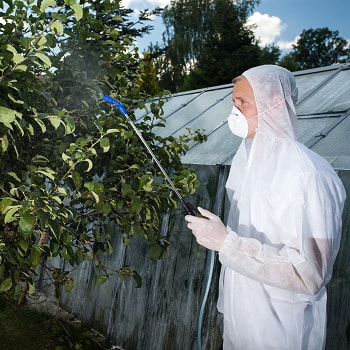Chewing Insects
Defoliating insects migrate to the foliage of a tree and feed on the leaves. Other chewing insects attack the fruit. Caterpillars and beetles make up the largest proportion of chewing insects. Generally, trees can bounce back from an attack of these defoliators, though repeat infestation will weaken a tree and can eventually kill it by starving it of energy.
Examples: Spring and Fall Cankerworm, Tent Caterpillar, Gypsy Moth, Leafminers, Japanese Beetle, Apple Maggot
Control: Healthier trees are less likely to become infested, so maintaining the strength and vitality of your tree is an important prevention step. Once chewing insects are present, controlling movement up and down the stem with physical barriers can interrupt the lifecycles of many caterpillars. Insecticides can be used to kill the insects.
 Boring Insects
Boring Insects
Boring, or tunneling, insects cause damage by boring into the stem, roots, or twigs of a tree. Some lay eggs which then hatch and the larvae burrow more deeply into the wood blocking off the water-conducting tissues of the tree. Boring insects generally feed on the vascular tissues of the tree. If the infestation is serious, the upper leaves are starved of nutrients and moisture and the tree can die. Signs of borer infestation include entry/exit holes in the bark, small mounds of sawdust at the base, and sections of the crown wilting and dying.
Examples: Asian Longhorned Beetle, Bronze Birch Borer, Dogwood Borer, Elm Bark Beetle
Control: The key is to prevent infestation by keeping the tree as healthy as possible. This includes proper pruning, watering, mulching and fertilization. Dead or fallen wood should be removed immediately. Once borers are present, control becomes extremely difficult. For recommendations on treating boring insect infestations, contact a qualified local arborist.
Sucking Insects
These insects do their damage by sucking out the liquid from leaves and twigs. Many sucking insects (e.g. scale insects) are relatively immobile, living on the outside of a branch and forming a hard protective outer coating while they feed on the plant juices in the twig. Quite often they will excrete a sweet, sticky substance known as honeydew which contains unprocessed plant material. Honeydew can cause sooty mold to form on leaves and can become a nuisance for homeowners. Signs of infestation include scaly formations on branches, dieback of leaves, and honeydew production.
Examples: Scale Insects, Aphids, Leafhoppers, Spider Mites, Thrips
Control: As with other insect infestations, prevention is the best approach. This means maintaining a strong and healthy tree. Once they mature on the tree, sucking insects generally must be killed on contact.





